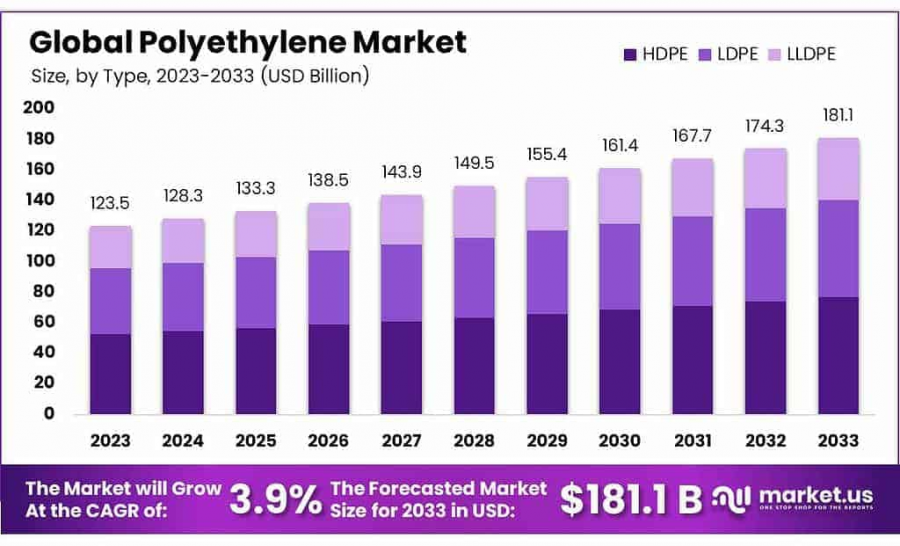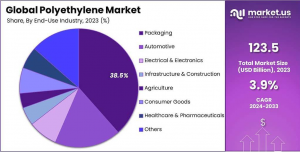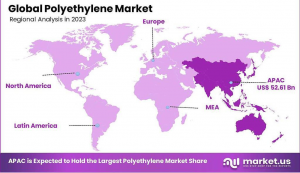
Polyethylene Market to Reach USD 181.1 Billion by 2033, Expanding at a 3.9% CAGR Growth from 2023 to 2033
Polyethylene market size is expected to be worth around USD 181.1 billion by 2033, from USD 123.5 billion in 2023, growing at a CAGR of 3.9%
NEW YORK, NY, UNITED STATES, January 29, 2025 /EINPresswire.com/ -- Polyethylene Market Overview
The polyethylene market is anticipated to reach USD 181.1 billion by 2033, expanding from USD 123.5 billion in 2023 at a CAGR of 3.9%. As a versatile and widely used polymer, polyethylene is lauded for its durability, lightweight, and resistance to moisture and chemicals, making it integral to products such as packaging materials, containers, and piping. The market is predominantly segmented by types - high-density polyethylene (HDPE), low-density polyethylene (LDPE), and linear low-density polyethylene (LLDPE) - with HDPE leading due to its exceptional physical properties and broad application range.
Regional dynamics highlight Asia Pacific, particularly China and India, as significant contributors to global production and consumption, influenced by rapid industrialization and urbanization. Meanwhile, North America and Europe also secure substantial market shares given their technological advancements and high demand across various industries. Notably, sustainability trends and environmental regulations have spurred innovations in bio-based and recycled polyethylene production, propelling market players to enhance capabilities via strategic partnerships and capacity expansions. These developments aim to meet rising consumer and regulatory expectations for eco-friendly alternatives amidst fluctuating crude oil prices and evolving consumer preferences.
👉 Request a free sample PDF report for valuable insights: https://market.us/report/polyethylene-market/request-sample/
Experts Review
Government incentives and technological innovations are pivotal in driving the polyethylene market forward. Incentives promoting sustainable practices have led to advancements in bio-based polyethylene production, aiding companies in adhering to regulatory frameworks and addressing environmental concerns. However, these initiatives also pose risks as they require substantial investment and pose challenges in meeting regulatory compliance. Investment opportunities abound, particularly in bio-based alternatives and advanced recycling technologies, which promise lucrative returns given the growing consumer demand for sustainable products. Yet, these investments entail risks, primarily due to fluctuating raw material costs and evolving regulations.
Technological impacts are noteworthy, with enhancements in production processes improving product qualities such as strength and flexibility, thereby expanding application potential across industries. Consumer awareness of environmental issues is simultaneously pressuring companies to innovate green solutions that meet heightened sustainability expectations. The regulatory environment continues to tighten with increased scrutiny on plastic usage and waste management, necessitating strategic pivots by manufacturers to maintain compliance and competitive advantage. Overall, the interplay of incentives, innovations, and consumer behaviors shapes a polyethylene industry poised for growth but tempered by substantial regulatory and investment challenges.
Report Segmentation
The polyethylene market report is methodically segmented to provide comprehensive insights across several axes: by type, product category, end-use industry, and region. By Type, the market is categorized into high-density polyethylene (HDPE), low-density polyethylene (LDPE), and linear low-density polyethylene (LLDPE), each defined by distinct molecular properties and application suitability. HDPE dominates due to its robustness, impacting sectors from packaging to construction. By Product Category, it is divided into green polyethylene, emphasizing bio-based innovations, and synthetic, with the latter maintaining a lead due to established production infrastructures and cost advantages.
By End-Use Industry, the segmentation includes packaging, automotive, construction, electronics, agriculture, and more, with packaging emerging as a major driver due to polyethylene's adaptability across diverse packaging solutions. In terms of Regional Analysis, Asia Pacific leads, thanks to intense industrial growth and urbanization, with North America and Europe also holding notable market shares due to technological prowess and substantial industry demand. This detailed segmentation not only highlights the market's versatility but also underscores the strategic areas for stakeholders to focus on, guiding investment and developmental strategies across the global landscape.
Key Market Segmentation
Based on Type
• HDPE
• LDPE
• LLDPE
Based on Product Category
• Green Polyethylene/Bio-Based
• Synthetic
Based on End-Use Industry
• Packaging
• Automotive
• Electrical & Electronics
• Infrastructure & Construction
• Agriculture
• Consumer Goods
• Healthcare & Pharmaceuticals
• Others
👉 Buy Now to access the full report: https://market.us/purchase-report/?report_id=112744
Drivers, Restraints, Challenges, and Opportunities
Key drivers of the polyethylene market include the growing demand from the packaging industry, driven by characteristics like moisture resistance and flexibility. The rapid expansion of e-commerce and retail sectors amplifies this demand, particularly for HDPE products. Meanwhile, increasing construction activities bolster market growth through applications in piping and insulation. However, significant restraints emerge from environmental concerns and strict regulatory policies aimed at reducing plastic pollution, pushing the market to seek sustainable materials. Challenges are further compounded by the volatile costs of raw materials linked to fluctuating crude oil prices, which can affect production economics. Nonetheless, opportunities abound, especially through advancements in recycling technologies, offering ways to address environmental issues and create a circular economy. Technological innovations in bioplastics and bio-based polyethylene present additional growth avenues, driven by a shift towards sustainable products. Players that invest in these technologies and adapt to evolving regulatory landscapes stand to benefit. As the market navigates these complexities, balancing growth with environmental responsibility becomes imperative for sustainable progress and market leadership.
Key Player Analysis
In the competitive landscape of the polyethylene market, companies like Solvay, Honeywell International, Arkema Group, and LyondellBasell Industries stand out as key players. These organizations focus heavily on research and development to produce innovative polyethylene solutions that meet modern industry demands while addressing sustainability challenges. For instance, LyondellBasell has made significant investments in recycling infrastructure, aligning with the industry's move towards sustainable practices.
Similarly, Arkema Group has emphasized the development of high-performance polyethylene blends suited for diverse applications, from packaging to automotive. Strategic collaborations and expansions are a common theme, as seen in partnerships to enhance technological capabilities and broaden market reach. These companies leverage their global presence and technological expertise to maintain competitiveness, focusing on product innovation, efficient production processes, and comprehensive market strategies that cater to evolving consumer preferences and stringent regulatory requirements.
Market Key Players
• The Dow Chemical Company
• LyondellBasell Industries N.V.
• ExxonMobil Corporation
• The China National Petroleum Corporation
• Reliance Industries Limited
• Ineos Group Limited
• Ducor Petrochemicals B.V.
• Repsol S.A.
• Borealis AG
• MOL Group
• Braskem
• Chevron Phillips Chemical
• LG Chem Ltd.
• Other Key Players
Recent Developments
Several recent developments underscore the dynamic and innovative nature of the polyethylene market. Notably, in early 2023, LyondellBasell announced a partnership with KIRKBI A/S to invest in APK, strengthening efforts towards advanced recycling solutions for LDPE. This move aligns with broader trends towards sustainability and resource efficiency. In another strategic endeavor, LyondellBasell acquired a significant share in Rodepa Vastgoed B.V., focusing on augmenting the supply of recyclable raw materials. Furthermore, ISCO Industries' acquisition of Infinity Plastics in late 2023 amplifies its capabilities in HDPE piping production, indicating a focus on infrastructure applications. These developments highlight a clear industry trend: investing in technologies and partnerships that enhance recycling capabilities and expand the application of polyethylene across sectors. Such strategic initiatives are critical as companies navigate the complex landscape of regulatory demands, environmental sustainability, and burgeoning market opportunities.
Conclusion
The polyethylene market is on a trajectory of steady growth, supported by its expansive use across industries and evolving consumer demands for sustainable solutions. Despite the challenges posed by environmental regulations and volatile raw material costs, innovations in recycling and bio-based technologies offer promising avenues for market expansion. Strategic investments and collaborations among key players will continue to shape the competitive landscape, ensuring adaptability to regulatory pressures and shifting market paradigms. As the industry progresses, balancing economic viability with environmental responsibility will be crucial in achieving long-term success and growth in the global polyethylene market.
View More Trending Reports:
— Electroplating Market: https://market.us/report/electroplating-market/
— Benzotrifluoride Market: https://market.us/report/benzotrifluoride-market/
— Ethyl Acetate Market: https://market.us/report/ethyl-acetate-market/
— Octyl Methoxycinnamate Market: https://market.us/report/octyl-methoxycinnamate-market/
— Ethoxydiglycol Market: https://market.us/report/ethoxydiglycol-market/
— Luminous Paint Market: https://market.us/report/luminous-paint-market/
— Fortified Rice Market: https://market.us/report/fortified-rice-market/
— Silica Fume Market: https://market.us/report/silica-fume-market/
— Cavitated Films Market: https://market.us/report/cavitated-films-market/
— Plastic Drums Market: https://market.us/report/plastic-drums-market/
Lawrence John
Prudour
+91 91308 55334
Lawrence@prudour.com
Visit us on social media:
Facebook
LinkedIn
Distribution channels: Chemical Industry
Legal Disclaimer:
EIN Presswire provides this news content "as is" without warranty of any kind. We do not accept any responsibility or liability for the accuracy, content, images, videos, licenses, completeness, legality, or reliability of the information contained in this article. If you have any complaints or copyright issues related to this article, kindly contact the author above.
Submit your press release


